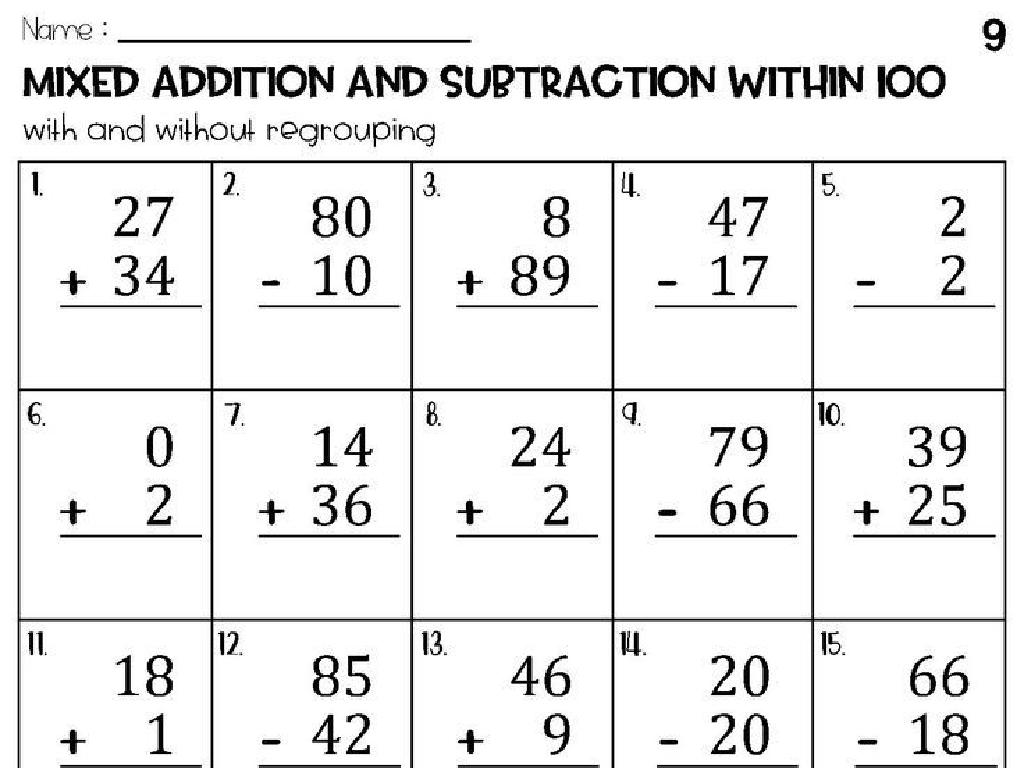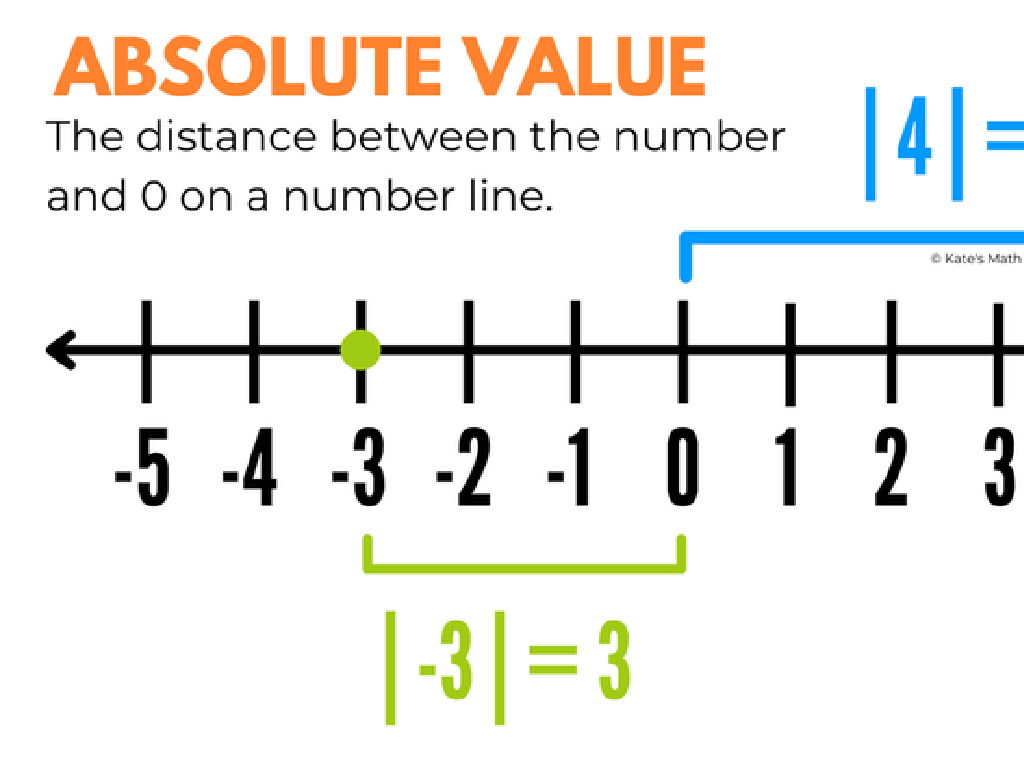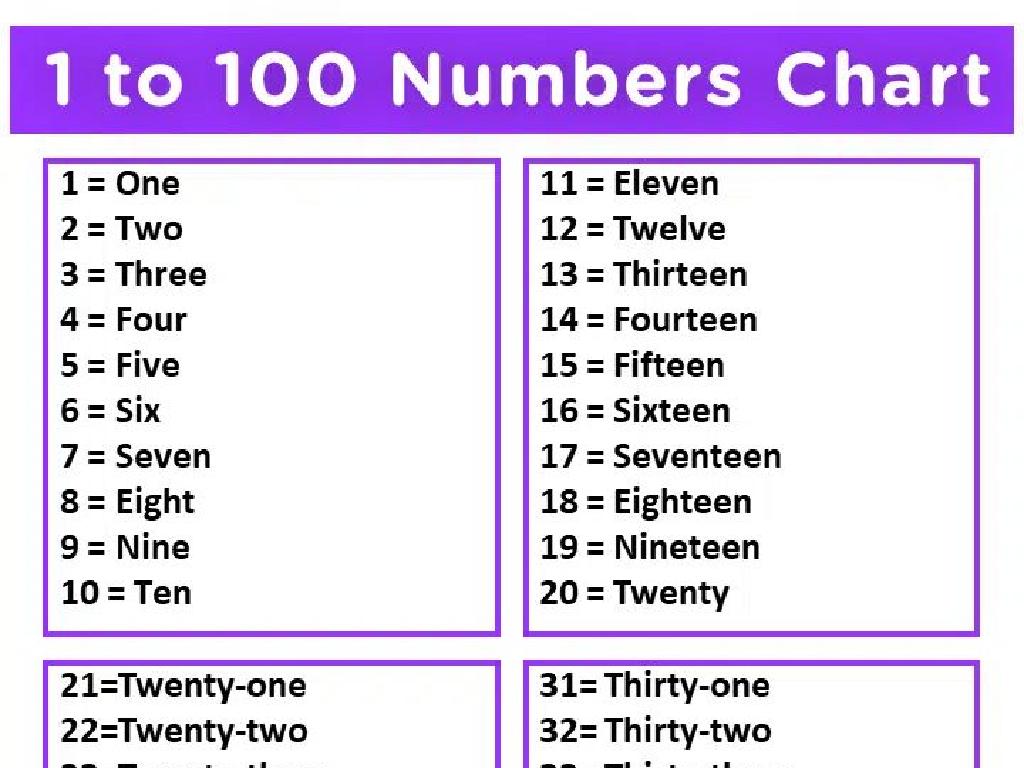Multiply And Divide Powers: Variable Bases
Subject: Math
Grade: Eighth grade
Topic: Exponents
Please LOG IN to download the presentation. Access is available to registered users only.
View More Content
Multiplying & Dividing Powers with Variable Bases
– Exponents represent repeated multiplication
– For example, 3^4 means 3 x 3 x 3 x 3
– Review of numeric base exponents
– Recall: 2^3 = 2 x 2 x 2
– Today’s focus: variable base exponents
– Variables as bases, e.g., x^m * x^n
– Applying rules to multiply/divide variables
– Use laws of exponents for variables
|
Begin with a brief explanation of exponents as a way to denote repeated multiplication, which will help students understand the concept of raising a number to a power. Recap the work done with numeric bases to ensure a solid foundation. The main focus of today’s lesson is on variable bases this is where students apply their understanding of exponents to algebraic expressions. Emphasize the rules for multiplying and dividing powers with the same base, such as adding and subtracting exponents, respectively. Provide examples like x^3 * x^2 = x^(3+2) and x^5 / x^2 = x^(5-2). This will prepare students for more complex algebraic manipulations involving exponents.
Multiplying Powers with the Same Base
– Rule for multiplying powers
– Add exponents with the same base
– Example: x^3 * x^2
– x^3 * x^2 equals x raised to (3+2), which is x^5
– Practice Problem: y^4 * y^3
– Simplify y^4 * y^3 to find y raised to what power?
|
This slide introduces the rule for multiplying powers with the same base, which is a fundamental concept in working with exponents. The rule is simple: when multiplying, add the exponents if the bases are the same. The example provided uses a variable base ‘x’ to demonstrate this rule. For the practice problem, students are encouraged to apply the rule by simplifying the expression y^4 * y^3. The expected answer is y^7, as 4+3=7. This exercise will help solidify their understanding of the rule. Encourage students to work through the problem and explain their reasoning. This concept is a building block for more complex operations in algebra.
Dividing Powers with the Same Base
– Rule for dividing powers
– Subtract exponents when bases are same
– Subtract exponents example
– For a^5 / a^2, subtract 2 from 5 to get a^3
– Practice Problem
– Simplify m^7 / m^4 to find the solution
|
This slide introduces the rule for dividing powers with the same base, which is a fundamental concept in working with exponents. The rule is simple: when dividing like bases, subtract the exponent of the denominator from the exponent of the numerator. The example provided, a^5 / a^2 = a^(5-2) = a^3, illustrates this rule. For the practice problem, students should apply the rule to simplify m^7 / m^4. The expected answer is m^(7-4) = m^3. Encourage students to work through the problem and verify their understanding of the rule. This exercise will help solidify their grasp of exponent operations and prepare them for more complex algebraic manipulations involving variable bases.
Zero and Negative Exponents
– Base to zero power equals one
– Negative exponents invert base
– For a^-n, think of it as 1 over a^n
– Simplify (2x)^0
– Any number to the zero power is 1, so (2x)^0 = 1
– Simplify y^-3
– y^-3 means 1 over y cubed or 1/y^3
|
Begin with a review of the concept that any non-zero base raised to the zero power equals one. This is a fundamental rule in exponents and serves as a foundation for understanding negative exponents. Next, explain that a negative exponent indicates the reciprocal of the base raised to the corresponding positive exponent. Provide the practice problems (2x)^0 and y^-3 to apply these concepts. For (2x)^0, reinforce that anything to the zero power is 1. For y^-3, guide students to see that it represents 1 divided by y cubed. Encourage students to work through these examples and come up with similar problems to ensure they grasp the concept.
Multiplying Powers with Variable Bases
– Apply exponent rules to variables
– Variables follow the same exponent rules as constants
– Example: Multiply (2x^3)(3x^2)
– Combine coefficients and add exponents: 2*3=x^(3+2) = 6x^5
– Practice: Simplify (a^4b^3)(a^2b^5)
– Multiply coefficients, add exponents of like bases: a^(4+2)b^(3+5)
|
When multiplying powers with variable bases, the same rules for exponents apply as with numerical bases. Students should multiply the coefficients (numerical parts) and add the exponents of like bases. For example, (2x^3)(3x^2) becomes 6x^5 because 2 and 3 are multiplied to get 6, and the exponents 3 and 2 are added to get 5. For the practice problem, students should simplify (a^4b^3)(a^2b^5) by multiplying the coefficients (which are implied to be 1 in this case) and adding the exponents of like bases to get a^6b^8. This exercise reinforces the concept of exponent addition when multiplying and helps students become familiar with handling variables in algebraic expressions.
Class Activity: Exponent Relay
– Form groups of four students
– Solve exponent problems collaboratively
– Each member completes one step
– Race to finish first with correct answers
– The winning group receives a special reward
|
This activity is designed to encourage teamwork and reinforce the concept of multiplying and dividing powers with variable bases. Each group of four will work together to solve a series of exponent problems. The problems should be broken down into steps that build upon each other, with each student responsible for one step in the sequence. This relay-style approach adds an element of fun and competition to the learning process. The teacher should prepare problems of appropriate difficulty and ensure that each step is clear and manageable. Possible prizes could include homework passes, extra credit points, or small treats. The goal is to create an engaging and interactive environment that promotes learning through collaboration.
Homework and Wrap-up: Exponents
– Assign exponent practice problems
– Review rules for powers
– Remember: To multiply powers with the same base, add the exponents. To divide, subtract them.
– Encourage question preparation
– Think of any areas you found challenging and formulate questions.
– Reflect on today’s lesson
– Take a moment to consider what was learned and what can be improved.
|
As we conclude today’s lesson on multiplying and dividing powers with variable bases, assign a set of practice problems that cover a range of difficulties to ensure students understand the concepts. Recap the key rules for multiplying and dividing powers to reinforce learning. Encourage students to review the lesson and come prepared with questions for the next class, fostering a proactive approach to learning. Remind them that understanding exponents is fundamental in algebra and will be used in future math concepts. Provide a few examples of how these rules apply to the homework problems to guide their practice.






